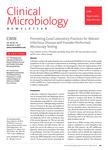版权所有:内蒙古大学图书馆 技术提供:维普资讯• 智图
内蒙古自治区呼和浩特市赛罕区大学西街235号 邮编: 010021

作者机构:TriHealth Laboratories Department of Pathology and Laboratory Medicine University of Cincinnati College of Medicine Cincinnati OH United States Laboratory Response Branch Bioterrorism Preparedness and Response Program Centers for Disease Control and Prevention Atlanta GA United States LabCorp Tucker GA United States
出 版 物:《Clinical Microbiology Newsletter》 (Clin. Microbiol. Newsl.)
年 卷 期:2006年第28卷第14期
页 面:105-110页
学科分类:0710[理学-生物学] 1004[医学-公共卫生与预防医学(可授医学、理学学位)] 1002[医学-临床医学] 1001[医学-基础医学(可授医学、理学学位)] 10[医学]
摘 要:For the last several years, most clinical microbiologists have heard, talked, and thought about;have been threatened with;or have actually experienced the consolidation of clinical microbiology (CM) services. We present (i) concepts, experiences, and practices that we and others have found to be successful during the operation of consolidated CM laboratories, (ii) practices that were disappointingly unsuccessful, (iii) seven decisions that can increase the chances of maintaining high-quality CM services after consolidation, and (iv) studies performed to evaluate and compare the results of practical clinical microbiology testing performed at core laboratories and those performed at associated rapid response (i.e., stat, on-site, in-house, or primary) laboratories. If culture protocols are optimized for efficiency and clinical relevance, and if appropriately experienced personnel staff the core laboratory, the laboratory can provide CM services that meet or exceed those currently provided by the in-house laboratory of the local facility or hospital. © 2006 Elsevier Inc. All rights reserved.